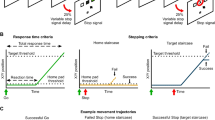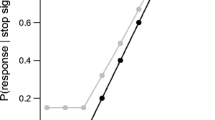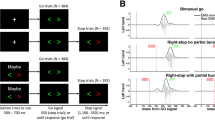Abstract
An important aspect of everyday behaviour is the ability to cancel a prepared movement. In Experiment 1, subjects prepared a response, and then either executed it in response to a subsequent Go signal, or cancelled the movement if a NoGo signal occurred. Subjects had to detect weak shocks, which were delivered after the signals on some trials. Results were compared to a prior instruction condition in which subjects knew at the start of the trial if they should move or not. We found that detection rates on move trials were lower than on non-move trials, consistent with sensory suppression. There was no difference between conditions in detection for move trials. However, detection rates for non-move trials were significantly lower in the NoGo than in the prior instruction condition, suggesting an element of sensory suppression associated with actions, which are prepared, but then inhibited before execution. In Experiment 2, the delay between the NoGo signal and shock was varied. Detection rates improved monotonically as the interval increased from 0 up to 200 ms. The recovery from sensory suppression offers a new way of measuring the processes triggered by a NoGo signal. Our results suggest that when a prepared movement is inhibited the dismantling of the sensory consequences of the motor command takes at least 200 ms.


Similar content being viewed by others
References
Aron AR, Poldrack RA (2006) Cortical and subcortical contributions to stop signal response inhibition: role of the subthalamic nucleus. J Neurosci 26(9):2424–2433
Band GPH, Van der Molen MW, Logan GD (2003) Horse-race model simulations of the stop-signal procedure. Acta Psychol 112:105–142
Chapin JK, Woodward DJ (1982) Somatic sensory transmission to the cortex during movement: gating of single cell responses to touch. Exp Neurol 78:654–669
Chapman CE, Bushnell MC, Miron D, Duncan GH, Lund JP (1987) Sensory perception during movement in man. Exp Brain Res 683:516–24
Coxon JP, Stinear CM, Byblow WD (2007) Selective inhibition of movement. J Neurophysiol 97:2480–2489
De Jong R, Coles MG, Logan GD (1995) Strategies and mechanisms in nonselective and selective inhibitory motor control. J Exp Psychol Hum Percept Perform 21(3):498–511
Duysens J, Tax AA, Nawijn S, Berger W, Prokop T, Altenmuller E (1995) Gating of sensation and evoked potentials following foot stimulation during human gait. Exp Brain Res 1053:423–431
Haggard P, Whitford B (2004) Supplementary motor area provides an efferent signal for sensory suppression. Cogn Brain Res 191:52–58
Levitt H (1971) Transformed up–down methods in psychoacoustics. J Acoust Soc Am 49(2):467–477
Logan GD, Cowan WB, Davis KA (1984) On the ability to inhibit simple and choice reaction time responses: a model and a method. J Exp Psychol Hum Percept Perform 102:276–91
Morein-Zamir S, Chua R, Franks IM, Nagelkerke P, Kingstone AF (2007) Predictability influences stopping and response control. J Exp Psychol Hum Percept Perform 33:149–162
Morein-Zamir S, Chua R, Franks IM, Nagelkerke P, Kingstone AF (2006) Measuring online volitional response control with a continuous tracking task. Behav Res Meth 38:638–647
Rushton DN, Rothwell JC, Craggs MD (1981) Gating of somatosensory evoked-potentials during different kinds of movement in man. Brain 104(SEP):465–491
Seki K, Perlmutter SI, Fetz EE (2003) Sensory input to primate spinal cord is presynaptically inhibited during voluntary movement. Nat Neurosci 612:1309–1316
Voss M, Ingram JN, Haggard P, Wolpert DM (2006) Sensorimotor attenuation by central motor command signals in the absence of movement. Nat Neurosci 91:26–27
Williams SR, Shenasa J, Chapman CE (1998) Time course and magnitude of movement-related gating of tactile detection in humans I. Importance of stimulus location J Neurophysiol 792:947–963
Acknowledgments
EW was supported by a BBSRC Research Committee Studentship: BBS/S/A/2004/11082. Further technical support was provided by an MRC Cooperative Group Grant: G9806600.
Author information
Authors and Affiliations
Corresponding author
Rights and permissions
About this article
Cite this article
Walsh, E., Haggard, P. The internal structure of stopping as revealed by a sensory detection task. Exp Brain Res 183, 405–410 (2007). https://doi.org/10.1007/s00221-007-1128-4
Received:
Accepted:
Published:
Issue Date:
DOI: https://doi.org/10.1007/s00221-007-1128-4




